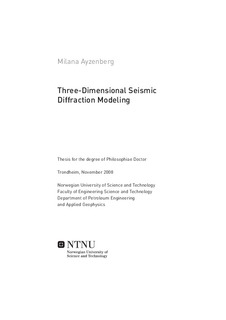| dc.contributor.author | Ayzenberg, Milana | nb_NO |
| dc.date.accessioned | 2014-12-19T12:14:10Z | |
| dc.date.available | 2014-12-19T12:14:10Z | |
| dc.date.created | 2009-01-22 | nb_NO |
| dc.date.issued | 2008 | nb_NO |
| dc.identifier | 139428 | nb_NO |
| dc.identifier.uri | http://hdl.handle.net/11250/239295 | |
| dc.description.abstract | Synthetic modeling of seismic wavefields scattered in the subsurface is of growing interest today due to its applicability in various forward and inverse problems of geophysics. It has been extensively used for general evaluation of the subsurface structure, in survey design and illumination studies, and also as the basis for imaging and inversion algorithms. A particular challenge is presented by models with complex geological structure containing strong-contrast or irregular reflectors and shadow zones, where conventional algorithms fail to simulate realistic wavefields. Therefore, the demand for advanced modeling techniques has dramatically increased.
This thesis is based on a new analytic approach to the description and modeling of three-dimensional reflected wavefields. The method combines surface singular integrals describing the wave propagation inside smoothly heterogeneous layers and effective reflection and transmission coefficients (ERC and ETC) at reflectors. The propagators are implemented using a seismic-frequency approximation of the Helmholtz-Kirchhoff integral. The approximation is based on the assumption that a small (compared to the predominant wavelength) part of the reflector acts as a secondary source, which, in accordance with Huygens’ principle, emits a wave beam. The beam comprises not only the main reflection or transmission, but also the edgediffracted and tip-diffracted waves. Because the tip-diffracted waves contribute most to the beam, the method is called the “tip-wave superposition method” (TWSM).
ERC and ETC generalize classical plane-wave reflection and transmission coefficients (PWRC and PWTC) for point sources and curved reflectors. Their definition accounts for the local interface curvature, sphericity of the wavefront, and finite frequency content of the incident wavelet. Therefore, they produce correct reflected and transmitted amplitudes at near-critical and post-critical incidence angles. Numerical experiments indicate that ERC and ETC also accurately reproduce amplitudes of the head waves. For a plane interface, ERC or ETC represents the exact reflection or transmission response at the reflector. For a curved interface, they are approximate and based on an “apparent“ source location, which depends on the incidence angle and the mean reflector curvature. Because ERC and ETC account for all amplitude-related effects, they are a useful tool for evaluation of reflected and transmitted wavefields at the reflector.
The new approach comprising the TWSM with ERC and ETC gives the possibility of reproducing complex wave phenomena such as caustics, diffractions, and head waves. The modeled full wavefield is represented as a set of separate events, each corresponding to a particular wavecode. This makes the approach event-oriented: an event of interest can be modeled separately. Numerical experiments demonstrate that the method simulates scattered 3D synthetic wavefields in layered media with accurate traveltimes and amplitudes.
Chapter 1 presents the basic principles of wave propagation in 3D media and an overview of existing modeling techniques. Chapter 2 contains a paper about 3D diffraction modeling of singly scattered acoustic wavefields. The paper introduces ERC and ETC for acoustic waves and gives a detailed overview of the acoustic version of TWSM. Chapter 3 contains a paper about 3D diffraction modeling of acoustic scattering in layered media. The paper deals with the extension of the acoustic version of TWSM for layered media. It provides a thorough analysis of the modeling results for 3D models with smoothly varying reflectors and for models containing diffracting edges. Chapter 4 contains a paper about ERC for curved interfaces in TI media. The paper analyzes the dependence of ERC on anisotropy parameters and reflector shape and demonstrates their advantages over PWRC in 3D diffraction modeling of PP and PS reflection data. | nb_NO |
| dc.language | eng | nb_NO |
| dc.publisher | Norges teknisk-naturvitenskapelige universitet, Fakultet for ingeniørvitenskap og teknologi, Institutt for petroleumsteknologi og anvendt geofysikk | nb_NO |
| dc.relation.ispartofseries | Doktoravhandlinger ved NTNU, 1503-8181; 2008:304 | nb_NO |
| dc.title | Three-Dimensional Seismic Diffraction Modeling | nb_NO |
| dc.type | Doctoral thesis | nb_NO |
| dc.contributor.department | Norges teknisk-naturvitenskapelige universitet, Fakultet for ingeniørvitenskap og teknologi, Institutt for petroleumsteknologi og anvendt geofysikk | nb_NO |
| dc.description.degree | PhD i petroleumsteknologi og anvendt geofysikk | nb_NO |
| dc.description.degree | PhD in Petroleum Engineering and Applied Geophysics | en_GB |

